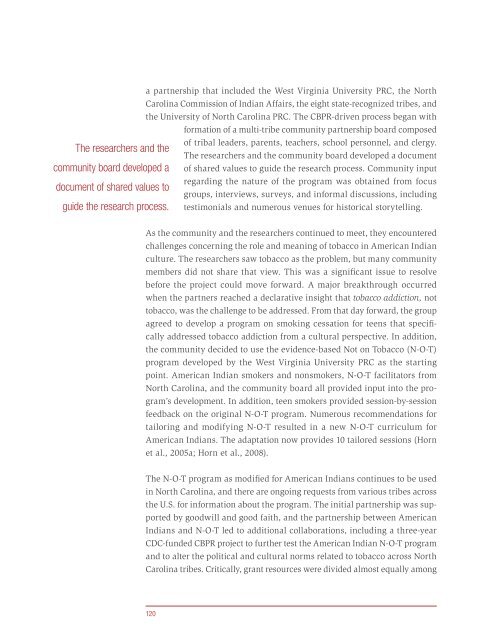Principles of Community Engagement (Second Edition)
Principles of Community Engagement (Second Edition)
Principles of Community Engagement (Second Edition)
Create successful ePaper yourself
Turn your PDF publications into a flip-book with our unique Google optimized e-Paper software.
The researchers and the<br />
community board developed a<br />
document <strong>of</strong> shared values to<br />
guide the research process.<br />
a partnership that included the West Virginia University PRC, the North<br />
Carolina Commission <strong>of</strong> Indian Affairs, the eight state-recognized tribes, and<br />
the University <strong>of</strong> North Carolina PRC The CBPR-driven process began with<br />
120<br />
formation <strong>of</strong> a multi-tribe community partnership board composed<br />
<strong>of</strong> tribal leaders, parents, teachers, school personnel, and clergy<br />
The researchers and the community board developed a document<br />
<strong>of</strong> shared values to guide the research process <strong>Community</strong> input<br />
regarding the nature <strong>of</strong> the program was obtained from focus<br />
groups, interviews, surveys, and informal discussions, including<br />
testimonials and numerous venues for historical storytelling<br />
As the community and the researchers continued to meet, they encountered<br />
challenges concerning the role and meaning <strong>of</strong> tobacco in American Indian<br />
culture The researchers saw tobacco as the problem, but many community<br />
members did not share that view This was a significant issue to resolve<br />
before the project could move forward A major breakthrough occurred<br />
when the partners reached a declarative insight that tobacco addiction, not<br />
tobacco, was the challenge to be addressed From that day forward, the group<br />
agreed to develop a program on smoking cessation for teens that specifically<br />
addressed tobacco addiction from a cultural perspective In addition,<br />
the community decided to use the evidence-based Not on Tobacco (N-O-T)<br />
program developed by the West Virginia University PRC as the starting<br />
point American Indian smokers and nonsmokers, N-O-T facilitators from<br />
North Carolina, and the community board all provided input into the program’s<br />
development In addition, teen smokers provided session-by-session<br />
feedback on the original N-O-T program Numerous recommendations for<br />
tailoring and modifying N-O-T resulted in a new N-O-T curriculum for<br />
American Indians The adaptation now provides 10 tailored sessions (Horn<br />
et al , 2005a; Horn et al , 2008)<br />
The N-O-T program as modified for American Indians continues to be used<br />
in North Carolina, and there are ongoing requests from various tribes across<br />
the U S for information about the program The initial partnership was supported<br />
by goodwill and good faith, and the partnership between American<br />
Indians and N-O-T led to additional collaborations, including a three-year<br />
CDC-funded CBPR project to further test the American Indian N-O-T program<br />
and to alter the political and cultural norms related to tobacco across North<br />
Carolina tribes Critically, grant resources were divided almost equally among

















